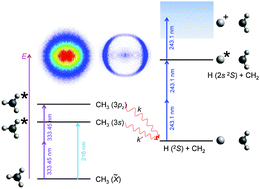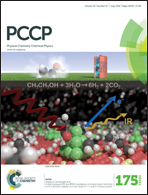Imaging the photodissociation dynamics of the methyl radical from the 3s and 3pz Rydberg states
Abstract
The photodissociation dynamics of the methyl radical from the 3s and 3pz Rydberg states have been studied using the velocity map and slice ion imaging in combination with pump–probe nanosecond laser pulses. The reported translational energy and angular distributions of the H(2S) photofragment detected by (2+1) REMPI highlight different dissociation mechanisms for the 3s and 3pz Rydberg states. A narrow peak in the translational energy distribution and an anisotropic angular distribution characterize the fast 3s photodissociation, while for the 3pz state Boltzmann-type translational energy and isotropic angular distributions are found. High level ab initio calculations have been performed in order to elucidate the photodissociation mechanisms from the two Rydberg states and to rationalize the experimental results. The calculated potential energy curves highlight a typical predissociation mechanism for the 3s state, characterized by the coupling between the 3s Rydberg state and a valence repulsive state. On the other hand, the photodissociation on the 3pz state is initiated by a predissociation process due to the coupling between the 3pz Rydberg state and a valence repulsive state and constrained, later on, by two conical intersections that allow the system to relax to lower electronic states. Such a mechanism opens up different reaction pathways leading to CH2 photofragments in different electronic states and inducing a transfer of energy between translational and internal modes.


 Please wait while we load your content...
Please wait while we load your content...